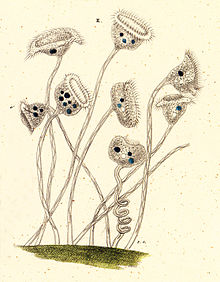
The Colpodea are a class of ciliates, of about 200 species common in freshwater and soil habitats. The body cilia are typically uniform, and are supported by dikinetids of characteristic structure, with cilia on both kinetosomes. The mouth may be apical or ventral, with more or less prominent associated polykinetids. Many are asymmetrical, the cells twisting sideways and then untwisting again prior to division, which often takes place within cysts. Colpoda, a kidney-shaped ciliate common in organic rich conditions, is representative.

Blepharisma is a genus of unicellular ciliate protists found in fresh and salt water. The group includes about 40 accepted species, and many sub-varieties and strains. While species vary considerably in size and shape, most are easily identified by their red or pinkish color, which is caused by granules of the pigment blepharismin.

Stentor, sometimes called trumpet animalcules, are a genus of filter-feeding, heterotrophic ciliates, representative of the heterotrichs. They are usually horn-shaped, and reach lengths of two millimeters; as such, they are among the largest known extant unicellular organisms. They reproduce asexually through binary fission.
Epistylis is a genus of usually colonial peritrich ciliates with a short oral disc and collar, and a rigid stalk. The rigid stalk differentiates Epistylis from the very similar genus Carchesium in which the stalks are contractile like those in Vorticella.
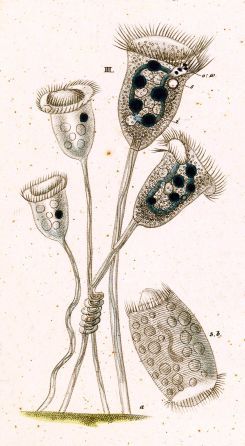
Vorticella is a genus of bell-shaped ciliates that have stalks to attach themselves to substrates. The stalks have contractile myonemes, allowing them to pull the cell body against substrates. The formation of the stalk happens after the free-swimming stage.
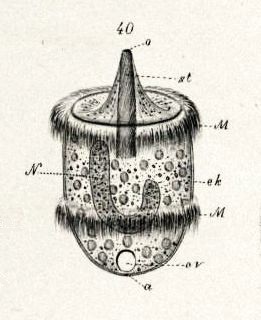
Didinium is a genus of unicellular ciliates with at least ten accepted species. All are free-living carnivores. Most are found in fresh and brackish water, but three marine species are known. Their diet consists largely of Paramecium, although they will also attack and consume other ciliates. Some species, such as D. gargantua, also feeds on non-ciliate protists, including dinoflagellates, cryptomonads, and green algae.

Paramecium caudatum is a species of unicellular protist in the phylum Ciliophora. They can reach 0.33 mm in length and are covered with minute hair-like organelles called cilia. The cilia are used in locomotion and feeding. The species is very common, and widespread in marine, brackish and freshwater environments.

Vorticella convallaria is a species of ciliates. It is the type species of the genus Vorticella. It resembles V. campanula, but differs in being somewhat narrow in the anterior end and usually having no refractile granules in the endoplasm.

The ciliates are a group of alveolates characterized by the presence of hair-like organelles called cilia, which are identical in structure to eukaryotic flagella, but are in general shorter and present in much larger numbers, with a different undulating pattern than flagella. Cilia occur in all members of the group and are variously used in swimming, crawling, attachment, feeding, and sensation.

Climacostomum is a genus of unicellular ciliates, belonging to the class Heterotrichea.
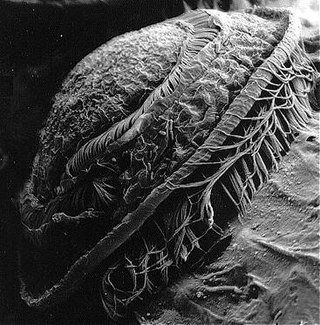
Trichodinidae is a family of ciliates of the order Mobilida, class Oligohymenophorea. Members of the family are ectoparasites of a wide variety of aquatic organisms, including fish, amphibians, hydrozoans, molluscs and crustaceans.

Mobilida is a group of parasitic or symbiotic peritrich ciliates, comprising more than 280 species. Mobilids live on or within a wide variety of aquatic organisms, including fish, amphibians, molluscs, cnidarians, flatworms and other ciliates, attaching to their host organism by means of an aboral adhesive disk. Some mobilid species are pathogens of wild or farmed fish, causing severe and economically damaging diseases such as trichodinosis.

Condylostoma is a genus of unicellular ciliate protists, belonging to the class Heterotrichea.
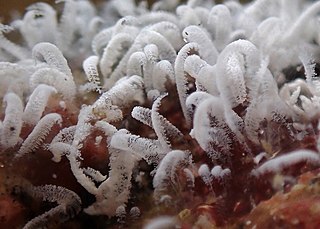
Sessilida is the largest order of the peritrich ciliates.

Cothurnia is a genus of freshwater and marine peritrichs in the family Vaginicolidae. It is characterised by living in a transparent tubular lorica. During the feeding or vegetative phase of its life cycle, Cothurnia attaches to submerged surfaces through a short stalk — mostly on the surfaces of fishes, crustaceans and aquatic plants. It is commonly studied for its epibiotic relationship with the host that it is attached to.

Loxodidae is a family of karyorelict ciliates.
Miamiensis avidus is a species of unicellular marine eukaryote that is a parasite of many different types of fish. It is one of several organisms known to cause the fish disease scuticociliatosis and is considered an economically significant pathogen of farmed fish. M. avidus is believed to be the cause of a 2017 die-off of fish and sharks in the San Francisco Bay.

Zoothamnium is a genus of ciliate protozoan.

Halteria, sometimes referred to as the jumping oligotrich, is a genus of common planktonic ciliates that are found in many freshwater environments. Halteria are easy to locate due to their abundance and distinctive behaviour with observations of Halteria potentially dating back to the 17th century and the discovery of microorganisms. Over time more has been established about their morphology and behavior, which has led to many changes in terms of classification.
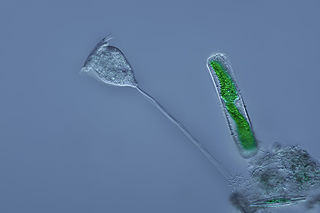
Vorticellidae is a family of ciliates belonging to the order Sessilida. They are colonial or unicellular organisms that are attached to a substrate via a stalk. The distinguishing characteristic of the family is a helical spasmoneme within the stalk that is contractile.
